A Review of Antibiotics Use in Aquaculture and Coastal Environments in Southeast Asia
Info: 11187 words (45 pages) Dissertation
Published: 13th Dec 2019
Tagged: Marine Studies
- Recent growth and trends in aquaculture and coastal farming:
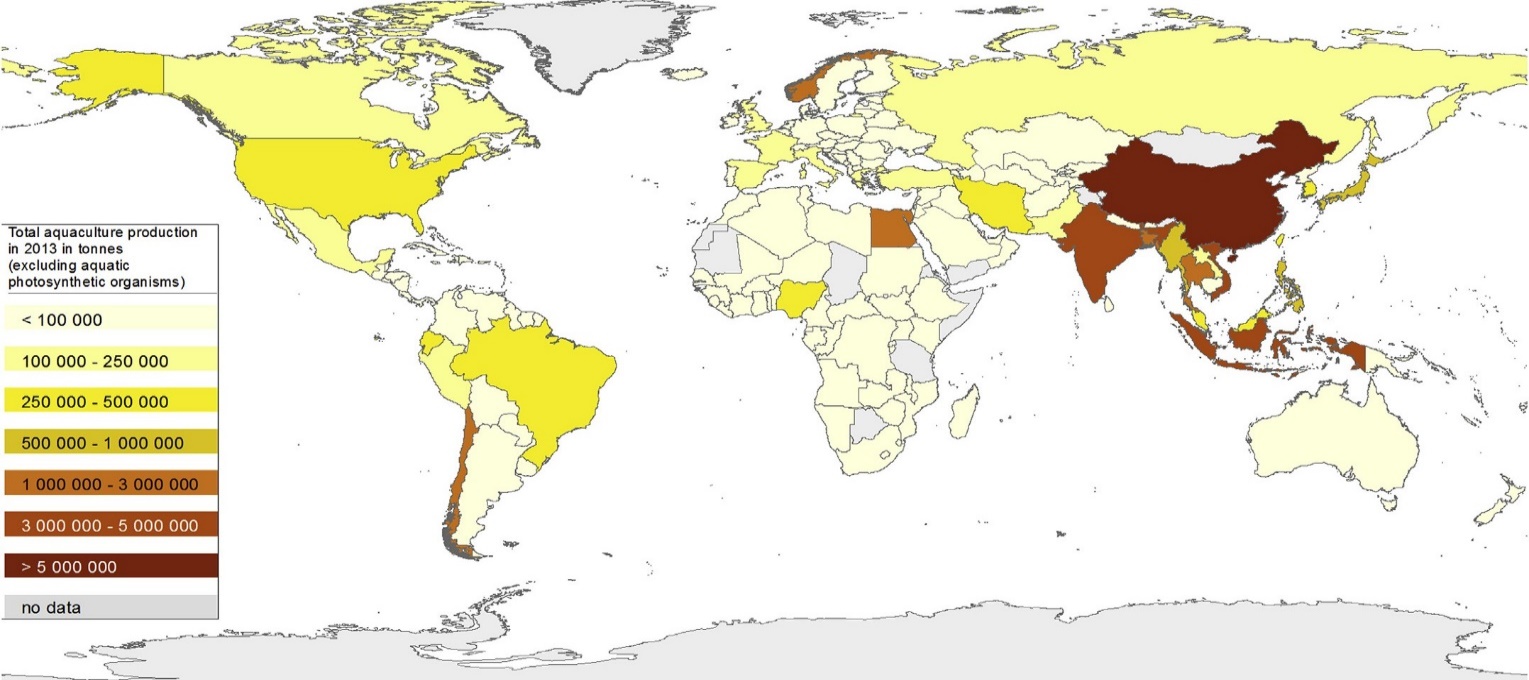 Figure 1. Map of global aquaculture production in 2013. Source of data: FAO (2015)
Throughout the literature review one of the main areas studied was China (figure 2), it was noted that they were one of the largest aquaculture producing countries in Southeast Asia (Msangi 2013) with an increasing growth in supply and demand. Due to a quick shift in China’s standard of living, income policy and preferences in aquaculture products this influences and have a large effect on global aquaculture and coastal market (Ahmed 2002). In a scenario projected by the authors, they considered a situation where there would be an accelerated shift in consumer preferences with respect to higher valued aquaculture products (Alexandratos 2012). The projection illustrated that in a situation such as this that there would be an exponential increase per capita consumption of high valued aquaculture products such as shrimp , mollusks , tuna and salmon and that it was projected to increase threefold over their projection to 2030 (figure 2).
Figure 1. Map of global aquaculture production in 2013. Source of data: FAO (2015)
Throughout the literature review one of the main areas studied was China (figure 2), it was noted that they were one of the largest aquaculture producing countries in Southeast Asia (Msangi 2013) with an increasing growth in supply and demand. Due to a quick shift in China’s standard of living, income policy and preferences in aquaculture products this influences and have a large effect on global aquaculture and coastal market (Ahmed 2002). In a scenario projected by the authors, they considered a situation where there would be an accelerated shift in consumer preferences with respect to higher valued aquaculture products (Alexandratos 2012). The projection illustrated that in a situation such as this that there would be an exponential increase per capita consumption of high valued aquaculture products such as shrimp , mollusks , tuna and salmon and that it was projected to increase threefold over their projection to 2030 (figure 2).
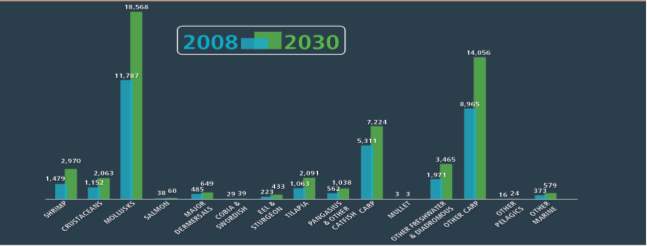 Figure 2. Illustrates the projected aquaculture production in China by their major species groups (‘000 tons).Source of data: (Msangi 2013)
2. Coastal aquaculture systems in South East Asia:
Figure 2. Illustrates the projected aquaculture production in China by their major species groups (‘000 tons).Source of data: (Msangi 2013)
2. Coastal aquaculture systems in South East Asia:
 Table 1. The types of coastal aquaculture systems used in Southeast Asia. Source: (Primavera 2006).
Table 1. The types of coastal aquaculture systems used in Southeast Asia. Source: (Primavera 2006).
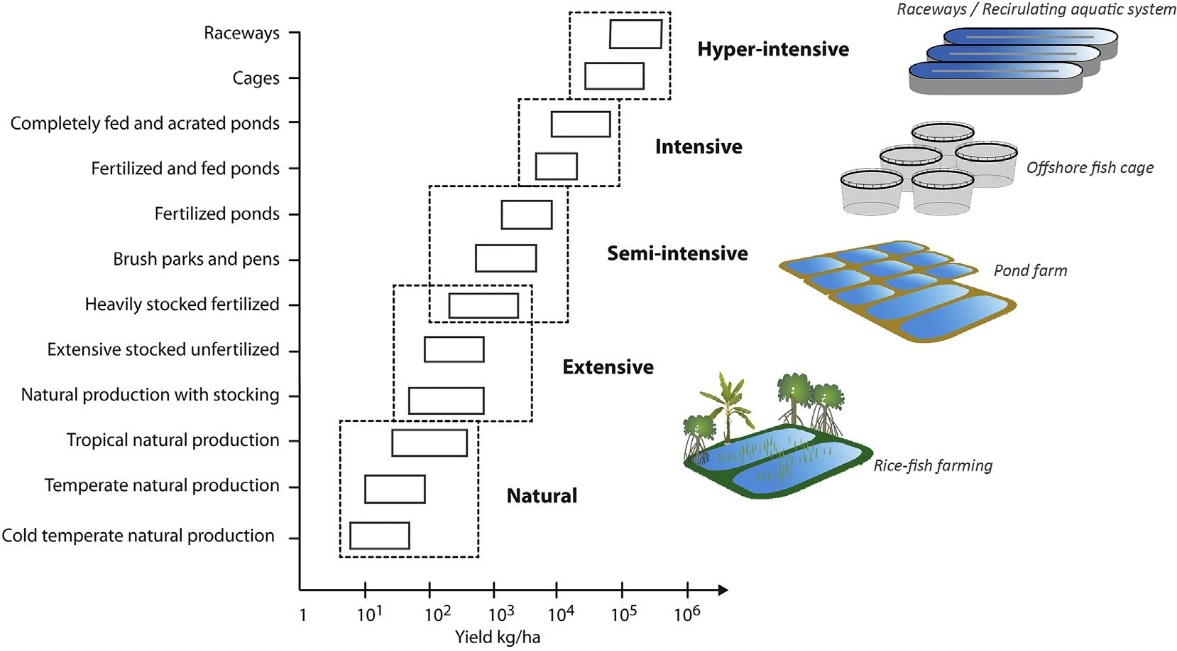 Figure 3. Production from different aquaculture systems. Source: Welcomme and Bartley (1998).
Coastal aquaculture systems range from semi-intensive, intensive and extensive in Southeast Asia (figure 3). The most popular groups of species grown are mollusks, crustaceans especially shrimp and fish (table 1). However many different species are reared and literature reviewed in the course of this review illustrated species such as eels, squids, octopus being grown in coastal farms. Although in Southeast Asian aquaculture they utilize numerous techniques to rear the various groups of species the most common systems used are rafts, pens, cages, longlines and stakes (table 1).
Aquaculture production in Southeast Asia is done on numerous scales, from large scale to small, the farmers use different techniques and systems to rear their respective species of aquaculture product (Kautsky 2000). In this review the literature illustrated that shrimp was a popular reared species and they were either white-legged shrimp or the black tiger shrimp. In coastal aquaculture, in marine or brackish environments grouper, snapper and milkfish were the most sought fish for aquaculture production and was a popular choice for the Asian community (De Silva 2009). Southeast Asia is known for their fondness of seafood and shellfish and hence produce on a very large scale to fulfill their high demand for import and export. Asia’s economy benefits significantly from the thriving aquaculture market as they export their products to all parts of the world. Aquaculture and coastal farming contributes significantly to their economy (Joshi 2004).
3. Main problems existing in aquaculture:
A number of problems have arisen due to aquaculture farming and in turn affects other animals, plants, humans and the environment (FAO 2014). Some of the main issues to be highlighted and of significant concern are ; (i) the environmental effects and impacts, (ii) habitat loss and modification, (iii) spread of diseases and pathogens, (iv) antibiotic and chemical usage, (v)water pollution caused by aquaculture waste, (vi) socio economic impacts (vii) erosion and land subsidence (viii) food chain pollution (Sabra 2015). However in this review the main problems studied were antibiotic resistance its use and pathogens affecting species being cultivated. These issues have impacted not only the Southeast Asian community but the entire world. Majority of literature revised illustrated that environmental effects caused were by the waste runoff of both aquaculture and coastal farms, domestic sewage and waste, municipal waste and hospital waste that led to antibiotic resistance genes and pathogens in the water (Choi 2014). The environment is consequently affected by this, as organisms are impacted as they develop antibiotic resistance and become infected with numerous pathogens especially of the Vibrio spp.
Pathogens tend to cause diseases which will be highlighted later on and these infected aquaculture and coastal species are consumed by humans who in turn become ill. Species cultivated in aquaculture and especially in coastal farms develop antibiotic resistant genes and when treated for illness cannot be cured. Chemical and biological products used pollute the environment via runoff and this enhances the other issues. Water pollution derived from aquaculture is a serious threat to not only all species of the environment, but the ecosystem and their natural habitats, food chains but humans as well (Pillay 2008).
Two major concerns of interest to be discussed, were antibiotic resistance and food borne illnesses derived from consumption of diseased aquaculture species (figure 4). This crisis extends beyond Southeast Asia to the entire world. As it is a growing issue that has developed within the last decade and has caused many illnesses and environmental issues. The development of antibiotic resistance is a serious global problem in the healthcare industry, and as of recent due, to the many incidents of antibiotic resistance and multiple antibiotic resistance, a lot of research is being done to mitigate , understand, source track, monitor and prevent this problem(Laxminarayan 2013). Advancement in technology and molecular testing techniques have been of great assistance in research so far. Governmental agencies, environmental monitoring agencies, universities and organizations, such as the Food and Agricultural Organizations (FAO), World Health organization (WHO) have propelled significant amount of resources, time and money to deal with this severe issue.
Figure 3. Production from different aquaculture systems. Source: Welcomme and Bartley (1998).
Coastal aquaculture systems range from semi-intensive, intensive and extensive in Southeast Asia (figure 3). The most popular groups of species grown are mollusks, crustaceans especially shrimp and fish (table 1). However many different species are reared and literature reviewed in the course of this review illustrated species such as eels, squids, octopus being grown in coastal farms. Although in Southeast Asian aquaculture they utilize numerous techniques to rear the various groups of species the most common systems used are rafts, pens, cages, longlines and stakes (table 1).
Aquaculture production in Southeast Asia is done on numerous scales, from large scale to small, the farmers use different techniques and systems to rear their respective species of aquaculture product (Kautsky 2000). In this review the literature illustrated that shrimp was a popular reared species and they were either white-legged shrimp or the black tiger shrimp. In coastal aquaculture, in marine or brackish environments grouper, snapper and milkfish were the most sought fish for aquaculture production and was a popular choice for the Asian community (De Silva 2009). Southeast Asia is known for their fondness of seafood and shellfish and hence produce on a very large scale to fulfill their high demand for import and export. Asia’s economy benefits significantly from the thriving aquaculture market as they export their products to all parts of the world. Aquaculture and coastal farming contributes significantly to their economy (Joshi 2004).
3. Main problems existing in aquaculture:
A number of problems have arisen due to aquaculture farming and in turn affects other animals, plants, humans and the environment (FAO 2014). Some of the main issues to be highlighted and of significant concern are ; (i) the environmental effects and impacts, (ii) habitat loss and modification, (iii) spread of diseases and pathogens, (iv) antibiotic and chemical usage, (v)water pollution caused by aquaculture waste, (vi) socio economic impacts (vii) erosion and land subsidence (viii) food chain pollution (Sabra 2015). However in this review the main problems studied were antibiotic resistance its use and pathogens affecting species being cultivated. These issues have impacted not only the Southeast Asian community but the entire world. Majority of literature revised illustrated that environmental effects caused were by the waste runoff of both aquaculture and coastal farms, domestic sewage and waste, municipal waste and hospital waste that led to antibiotic resistance genes and pathogens in the water (Choi 2014). The environment is consequently affected by this, as organisms are impacted as they develop antibiotic resistance and become infected with numerous pathogens especially of the Vibrio spp.
Pathogens tend to cause diseases which will be highlighted later on and these infected aquaculture and coastal species are consumed by humans who in turn become ill. Species cultivated in aquaculture and especially in coastal farms develop antibiotic resistant genes and when treated for illness cannot be cured. Chemical and biological products used pollute the environment via runoff and this enhances the other issues. Water pollution derived from aquaculture is a serious threat to not only all species of the environment, but the ecosystem and their natural habitats, food chains but humans as well (Pillay 2008).
Two major concerns of interest to be discussed, were antibiotic resistance and food borne illnesses derived from consumption of diseased aquaculture species (figure 4). This crisis extends beyond Southeast Asia to the entire world. As it is a growing issue that has developed within the last decade and has caused many illnesses and environmental issues. The development of antibiotic resistance is a serious global problem in the healthcare industry, and as of recent due, to the many incidents of antibiotic resistance and multiple antibiotic resistance, a lot of research is being done to mitigate , understand, source track, monitor and prevent this problem(Laxminarayan 2013). Advancement in technology and molecular testing techniques have been of great assistance in research so far. Governmental agencies, environmental monitoring agencies, universities and organizations, such as the Food and Agricultural Organizations (FAO), World Health organization (WHO) have propelled significant amount of resources, time and money to deal with this severe issue.
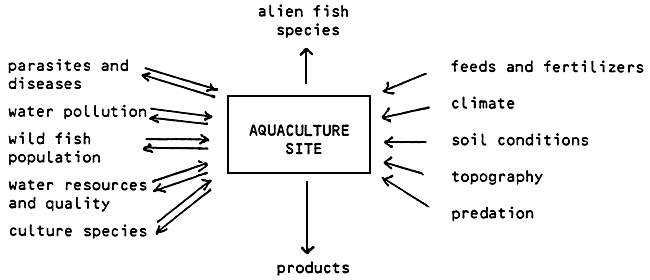 Figure 4: Bio-related effects of aquaculture farming. Source: FAO 2010
Figure 4: Bio-related effects of aquaculture farming. Source: FAO 2010
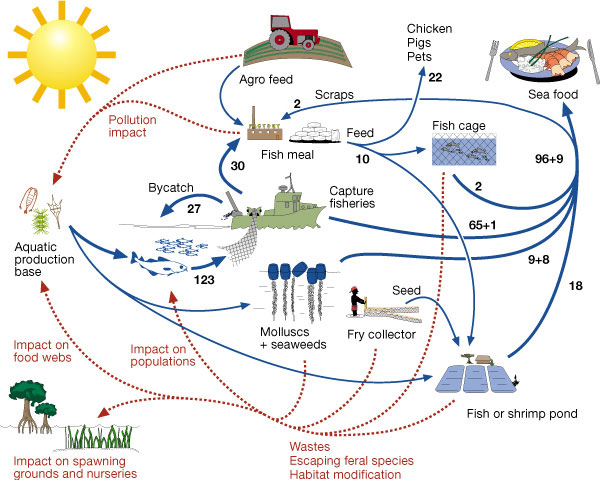 Figure 5: Ecological links between intensive fish and shrimp aquaculture and capture fisheries. Source: (Naylor 2000)
The thick blue lines denote major movements from aquatic production base through fisheries and aquaculture to when seafood is consumed by humans. Units of megatons (million metric tons) of fish, shellfish and seaweeds. Thin blue lines refer to other inputs needed for production (Naylor 2000). Hatched red lines show negative feedbacks.
4) Pathogens in aquaculture and coastal farming in South East Asia:
4.1. Development of aquaculture farming and disease problems:
Throughout the last few decades, a significant number of exotic species have been introduced accidentally outside their natural habitat due to aquaculture practices (Wilcove 1998).Aquaculture and coastal farming has in the past accidentally and sometimes intentionally introduced cultivated species into the environment. These non-native species have been documented to harm species and indigenous populations in various environments where the nonnative species may harm indigenous populations. An example of a known incident was the introduction of the northern Snakehead (picture1), which is a native predatory fish to China's Yangtze River region (Pimentel 2000).
Figure 5: Ecological links between intensive fish and shrimp aquaculture and capture fisheries. Source: (Naylor 2000)
The thick blue lines denote major movements from aquatic production base through fisheries and aquaculture to when seafood is consumed by humans. Units of megatons (million metric tons) of fish, shellfish and seaweeds. Thin blue lines refer to other inputs needed for production (Naylor 2000). Hatched red lines show negative feedbacks.
4) Pathogens in aquaculture and coastal farming in South East Asia:
4.1. Development of aquaculture farming and disease problems:
Throughout the last few decades, a significant number of exotic species have been introduced accidentally outside their natural habitat due to aquaculture practices (Wilcove 1998).Aquaculture and coastal farming has in the past accidentally and sometimes intentionally introduced cultivated species into the environment. These non-native species have been documented to harm species and indigenous populations in various environments where the nonnative species may harm indigenous populations. An example of a known incident was the introduction of the northern Snakehead (picture1), which is a native predatory fish to China's Yangtze River region (Pimentel 2000).
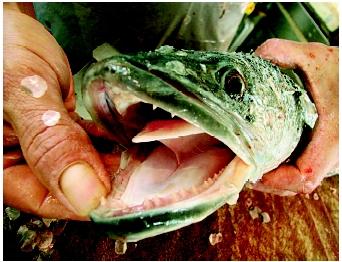 Picture 1. Shows a fish market vendor displaying the popular food item in parts of Asia, (Snakehead)
Two decades ago this Snakehead was found to be a highly invasive species in the United States (Simberloff 2005). Researchers deem them to be a serious threat to aquatic organism and their natural habitats and also indigenous species such as mollusks, crabs and clams. Many carp species from countries such as China and Vietnam are utilized by catfish farmers in the southern Parts of the United States for the purpose of farm pond management (Kurdila 1999). These have accidentally been introduced and have been noted to have rapidly spread in Mississippi and its tributaries which flow ultimately into many estuaries, rivers and lakes. The best way to address this serious issue and its environmental and ecological impacts of these nonnative species is to prevent their invasion and establishment, and this can be done by increasing public awareness via educational campaigns (Wittenberg 2001).
Numerous negative impacts occur due to this such as disruption and degradation of the host environment, degradation of the host stock and the introduction of diseases and parasites. These pathogens are passed throughout the community of the species and their environment, and infect the aquatic community and their natural habitats (Allan 1993). Other effects of concern is illness and increased mortality of species such as fish, shrimp and mollusks. Another issue of alarm to humans, are consumption of these diseased species and the contraction of food-borne illnesses.
Southeast Asia, being the world’s largest aquaculture producer and exporter, makes it a critical issue as diseased aquaculture products and pathogens are being spread worldwide (Reilly 1997). Pathogens of concern and constantly being researched are, Vibrio parahaemoliticus and Vibrio vulnificus as they are the leading causes of seafood associated infections and mortality (Archer 1988). Both pathogens are the leading causes of seafood borne illness and deaths and are naturally occurring estuarine bacteria (Haendiges 2014). The prevalence of these bacteria are high, and with time have become resistant to the antibiotics used by farmers. Farmers in South East Asia have been observed to use antibiotics and other chemicals irresponsibly, by its misuse and overuse and this has led to species developing antibiotic resistance and therefore being unable to be cured when infected with pathogens. In Asia especially in Southeast Asia , literature has illustrated that farmers are being affected significantly by diseases as mortality and illness of the aquaculture products make them incur financial loss and burden. Irresponsible farmers can sell these diseased products and this consequently causes threats of food borne illnesses being spread to consumers.
4.2 Role of pond and aquaculture environmental factors in disease outbreaks:
Picture 1. Shows a fish market vendor displaying the popular food item in parts of Asia, (Snakehead)
Two decades ago this Snakehead was found to be a highly invasive species in the United States (Simberloff 2005). Researchers deem them to be a serious threat to aquatic organism and their natural habitats and also indigenous species such as mollusks, crabs and clams. Many carp species from countries such as China and Vietnam are utilized by catfish farmers in the southern Parts of the United States for the purpose of farm pond management (Kurdila 1999). These have accidentally been introduced and have been noted to have rapidly spread in Mississippi and its tributaries which flow ultimately into many estuaries, rivers and lakes. The best way to address this serious issue and its environmental and ecological impacts of these nonnative species is to prevent their invasion and establishment, and this can be done by increasing public awareness via educational campaigns (Wittenberg 2001).
Numerous negative impacts occur due to this such as disruption and degradation of the host environment, degradation of the host stock and the introduction of diseases and parasites. These pathogens are passed throughout the community of the species and their environment, and infect the aquatic community and their natural habitats (Allan 1993). Other effects of concern is illness and increased mortality of species such as fish, shrimp and mollusks. Another issue of alarm to humans, are consumption of these diseased species and the contraction of food-borne illnesses.
Southeast Asia, being the world’s largest aquaculture producer and exporter, makes it a critical issue as diseased aquaculture products and pathogens are being spread worldwide (Reilly 1997). Pathogens of concern and constantly being researched are, Vibrio parahaemoliticus and Vibrio vulnificus as they are the leading causes of seafood associated infections and mortality (Archer 1988). Both pathogens are the leading causes of seafood borne illness and deaths and are naturally occurring estuarine bacteria (Haendiges 2014). The prevalence of these bacteria are high, and with time have become resistant to the antibiotics used by farmers. Farmers in South East Asia have been observed to use antibiotics and other chemicals irresponsibly, by its misuse and overuse and this has led to species developing antibiotic resistance and therefore being unable to be cured when infected with pathogens. In Asia especially in Southeast Asia , literature has illustrated that farmers are being affected significantly by diseases as mortality and illness of the aquaculture products make them incur financial loss and burden. Irresponsible farmers can sell these diseased products and this consequently causes threats of food borne illnesses being spread to consumers.
4.2 Role of pond and aquaculture environmental factors in disease outbreaks:
 Figure 6. Scheme of the Pangasius catfish pond and the water stream receiving the pond effluent, with the selected water and sediment sampling points (crosses). The effluent discharge points are indicated as DP1 and DP2, and the sampling points located in the water stream as S1–5. Source: (M. Andrieu et al.2015)
Aquaculture production continues to intensify, and with poor management and increased production, this has resulted in problems such as diseases, increased mortality and illness of aquaculture products. Subsequently they use and overuse antimicrobials and other chemicals for disease control (Wong 2017). The factor that is primarily responsible for disease outbreaks is poor water quality management. The rapid increase and intensification of aquaculture and pond farming in Southeast Asia has led to a significant increase in the risk of disease, spreading of pathogens and development of antibiotic resistant genes. This is due to increased rates of feeding and stocking densities which subsequently results in changes of the water quality properties (Flegel 2008). The poor water quality of the aquaculture farms harbors various pathogens and bacteria such as the Vibrio spp. and this affects and infects the aquaculture products. In an ecological risk assessment of antibiotics applied to catfish farms in Mekong delta, Vietnam (Andrieu 2015) data illustrated that the effluents contained antibiotics but posed minimal risk at that time, and were able to source track the discharge points (Figure 6)
Farmers in these less developed areas throughout the study area, whom have basic or little understanding of how to use antimicrobials and chemicals use them incorrectly and overuse as well. The waste of the these aquaculture environments and ponds are discarded and the runoff contains various virulent and non-virulent pathogens, bacteria related to food borne illnesses, high concentration of antimicrobials and chemicals (Manjusha 2006) .This waste then enters the coastal environment via mangroves, estuaries and rivers . It then spreads to sediment, water columns and pristine areas. Essentially the ponds and aquaculture farm harbors these bacteria’s, pathogens and other detrimental elements and are consequently released into the environment by wastewater and runoff.
4.2.1 Water pollution and degradation of the water quality:
This occurs when the aquaculture and wastewater runoff enters the environment and neighboring ecosystems. This is a serious problem as not only is the environment and coastal waters polluted but livelihoods and health of humans affected, flora and fauna are jeopardized and put at immense risk (Rose 2001). Water quality from this pollution directly affects all living things and has proven to be detrimental to human health, and the natural environment and also causes various socio-economic issues. Pathogens in the wastewater, contaminate the water and spread where it then infects the sediment, water columns and organisms. Aquaculture directly affects water quality as waste from the ponds and coastal farms flow to the sea/lakes and rivers which are used for recreation, drinking water for humans and animals and irrigation (Figure 7.) The degradation of crucial water bodies such as mangroves, lagoons, rivers, lakes results in severe environmental destruction and has the most serious effects on coastal environments and ecosystems (Islam 2004).Water pollution in these environments then leads to degradation of its quality and in turn causes food chain pollution.
Figure 6. Scheme of the Pangasius catfish pond and the water stream receiving the pond effluent, with the selected water and sediment sampling points (crosses). The effluent discharge points are indicated as DP1 and DP2, and the sampling points located in the water stream as S1–5. Source: (M. Andrieu et al.2015)
Aquaculture production continues to intensify, and with poor management and increased production, this has resulted in problems such as diseases, increased mortality and illness of aquaculture products. Subsequently they use and overuse antimicrobials and other chemicals for disease control (Wong 2017). The factor that is primarily responsible for disease outbreaks is poor water quality management. The rapid increase and intensification of aquaculture and pond farming in Southeast Asia has led to a significant increase in the risk of disease, spreading of pathogens and development of antibiotic resistant genes. This is due to increased rates of feeding and stocking densities which subsequently results in changes of the water quality properties (Flegel 2008). The poor water quality of the aquaculture farms harbors various pathogens and bacteria such as the Vibrio spp. and this affects and infects the aquaculture products. In an ecological risk assessment of antibiotics applied to catfish farms in Mekong delta, Vietnam (Andrieu 2015) data illustrated that the effluents contained antibiotics but posed minimal risk at that time, and were able to source track the discharge points (Figure 6)
Farmers in these less developed areas throughout the study area, whom have basic or little understanding of how to use antimicrobials and chemicals use them incorrectly and overuse as well. The waste of the these aquaculture environments and ponds are discarded and the runoff contains various virulent and non-virulent pathogens, bacteria related to food borne illnesses, high concentration of antimicrobials and chemicals (Manjusha 2006) .This waste then enters the coastal environment via mangroves, estuaries and rivers . It then spreads to sediment, water columns and pristine areas. Essentially the ponds and aquaculture farm harbors these bacteria’s, pathogens and other detrimental elements and are consequently released into the environment by wastewater and runoff.
4.2.1 Water pollution and degradation of the water quality:
This occurs when the aquaculture and wastewater runoff enters the environment and neighboring ecosystems. This is a serious problem as not only is the environment and coastal waters polluted but livelihoods and health of humans affected, flora and fauna are jeopardized and put at immense risk (Rose 2001). Water quality from this pollution directly affects all living things and has proven to be detrimental to human health, and the natural environment and also causes various socio-economic issues. Pathogens in the wastewater, contaminate the water and spread where it then infects the sediment, water columns and organisms. Aquaculture directly affects water quality as waste from the ponds and coastal farms flow to the sea/lakes and rivers which are used for recreation, drinking water for humans and animals and irrigation (Figure 7.) The degradation of crucial water bodies such as mangroves, lagoons, rivers, lakes results in severe environmental destruction and has the most serious effects on coastal environments and ecosystems (Islam 2004).Water pollution in these environments then leads to degradation of its quality and in turn causes food chain pollution.
![Epidemiology of antimicrobial resistance (adapted and modified from Linton [1977] by Rebecca Irwin, Health Canada [Prescott 2000] and IFT, with permission).](https://images.ukdissertations.com/4/0003818.009.jpg) Figure 7. Epidemiology of antimicrobial resistance. Source: (Prescott 2000)
4.3 Vibrio spp. virulence:
A major setback in aquaculture is the sudden outbreak of diseases especially those caused by Vibrio species which have proven to be a major problem globally. Global estimation of disease losses by the World Bank in 1997, was approximately US $3 Billion per year (Hunag 2013). Vibrio species is a genus of bacteria that are gram negative that is curved rod shaped (Igbinosa 2008). A number of species causes food borne illness and infections and is typically associated with consumption of undercooked seafood. They are mostly found in salt water and the species are facultative anaerobes. In this review data sourced indicated that the popular Vibrio spp. found in Southeast Asia that affected the aquaculture industry were, Vibrio parahemoleticus, Vibrio vulnificus, Vibrio alginoliticus and Vibrio harveii. Throughout the literature review it was seen that Vibrio parahemoleticus, Vibrio vulnificus, were two major pathogens affecting Southeast Asia.
The human pathogen Vibrio parahaemolyticus is broadly spread in the marine environments. Throughout the world and in Southeast Asia Vibrio spp. has been isolated from many types of seafood especially shellfish (Feldhusen 2000). The consumption of seafood contaminated with Vibrio parahaemolyticus, that is eaten when raw or undercooked results in acute gastroentitists with symptoms such as, headache, vomiting, diarrhea and abdominal cramps (Drais 2016). In many Asian countries such as China, Taiwan and Japan, this pathogen is a major cause of food borne illness and is also documented as a prominent cause of human gastroenteritis and food borne illness associated with seafood consumption in the United States (Yeung 2004).
The occurrence of different Vibrio spp. in water, sediment and shrimp samples from many farm environments from the east and west coast of India was studied and illustrated that types of virulent strains identified (Gopal 2005). V cholera, V parahaemolyticus and V vulnificus species have been noted as being the major cause of seafood borne illness, and it is imperative to be cautious and pay attention to cooking practices as well as post-harvest handling (Oetama 2016). A study done in Thailand on the occurrence of Vibrio spp. in two main shrimp species cultivated white-legged shrimp and Black tiger shrimp(picture 3) illustrated the prevalence of these Vibrio spp. (Table 2.).
A study done on clinical, environmental, and food sources on the Pacific, Atlantic, and Gulf Coasts of the United States and from clinical sources in Asia looked at potential virulence characteristics and serotypes of pathogenic Vibrio parahaemolyticus isolates. They concluded that specific serotypes had both clinical and environmental isolates while others just had environmental isolates; and this indicated that certain serotypes or ribotypes are more applicable for human disease (DePaola 2003).
Figure 7. Epidemiology of antimicrobial resistance. Source: (Prescott 2000)
4.3 Vibrio spp. virulence:
A major setback in aquaculture is the sudden outbreak of diseases especially those caused by Vibrio species which have proven to be a major problem globally. Global estimation of disease losses by the World Bank in 1997, was approximately US $3 Billion per year (Hunag 2013). Vibrio species is a genus of bacteria that are gram negative that is curved rod shaped (Igbinosa 2008). A number of species causes food borne illness and infections and is typically associated with consumption of undercooked seafood. They are mostly found in salt water and the species are facultative anaerobes. In this review data sourced indicated that the popular Vibrio spp. found in Southeast Asia that affected the aquaculture industry were, Vibrio parahemoleticus, Vibrio vulnificus, Vibrio alginoliticus and Vibrio harveii. Throughout the literature review it was seen that Vibrio parahemoleticus, Vibrio vulnificus, were two major pathogens affecting Southeast Asia.
The human pathogen Vibrio parahaemolyticus is broadly spread in the marine environments. Throughout the world and in Southeast Asia Vibrio spp. has been isolated from many types of seafood especially shellfish (Feldhusen 2000). The consumption of seafood contaminated with Vibrio parahaemolyticus, that is eaten when raw or undercooked results in acute gastroentitists with symptoms such as, headache, vomiting, diarrhea and abdominal cramps (Drais 2016). In many Asian countries such as China, Taiwan and Japan, this pathogen is a major cause of food borne illness and is also documented as a prominent cause of human gastroenteritis and food borne illness associated with seafood consumption in the United States (Yeung 2004).
The occurrence of different Vibrio spp. in water, sediment and shrimp samples from many farm environments from the east and west coast of India was studied and illustrated that types of virulent strains identified (Gopal 2005). V cholera, V parahaemolyticus and V vulnificus species have been noted as being the major cause of seafood borne illness, and it is imperative to be cautious and pay attention to cooking practices as well as post-harvest handling (Oetama 2016). A study done in Thailand on the occurrence of Vibrio spp. in two main shrimp species cultivated white-legged shrimp and Black tiger shrimp(picture 3) illustrated the prevalence of these Vibrio spp. (Table 2.).
A study done on clinical, environmental, and food sources on the Pacific, Atlantic, and Gulf Coasts of the United States and from clinical sources in Asia looked at potential virulence characteristics and serotypes of pathogenic Vibrio parahaemolyticus isolates. They concluded that specific serotypes had both clinical and environmental isolates while others just had environmental isolates; and this indicated that certain serotypes or ribotypes are more applicable for human disease (DePaola 2003).
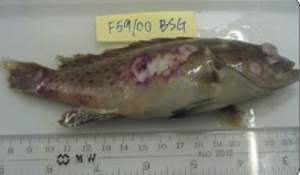 Picture 2. Typical ulcerative, pop-eye, fin and tail rot caused by Vibrio spp. in grouper. Source: BioAqua.vn
Picture 2. Typical ulcerative, pop-eye, fin and tail rot caused by Vibrio spp. in grouper. Source: BioAqua.vn
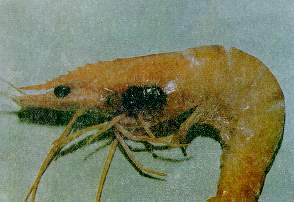 Picture 3: The affected P. monodon shrimp with Vibrio spp. show fungal / bacterial infections or necrosis of appendages, expanded chromophores, empty gut, absence of fecal strands and poor feeding. Cumulative mortalities may be up to 80% within few days. Source: BioAqua.vn
Picture 3: The affected P. monodon shrimp with Vibrio spp. show fungal / bacterial infections or necrosis of appendages, expanded chromophores, empty gut, absence of fecal strands and poor feeding. Cumulative mortalities may be up to 80% within few days. Source: BioAqua.vn
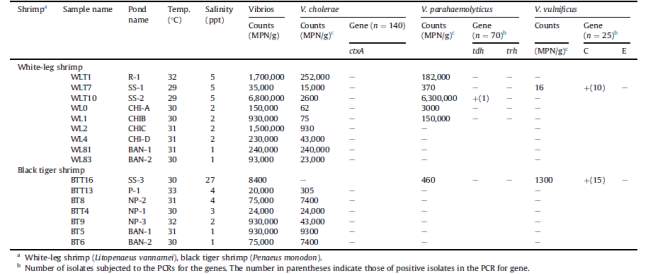 Table 2. The occurrence of Vibrio spp. in shrimp samples collected from cultured ponds in Thailand
Source: (Y. Yano et al 2014)
4.4 Current Methods to test for pathogens:
Traditionally researchers initially isolate the pathogen or bacteria to be studied via a media for the rapid detection and isolation of the isolates and then determine what it is, using various biochemical tests. A variety of molecular techniques have become popular for the proper identification and characterization of various pathogens and bacteria in aquaculture cultivation (Chatterjee 2012) .Antimicrobial susceptibility is tested for using the isolates and examined with a disc diffusion method according to the guidelines of the clinical and laboratory standards institute (CLSI 2012). Appropriate genetic fingerprinting methods are crucial for accurate, dependable and rapid tracking of pathogens such as Vibrio spp. In many of the more recent studies the researchers used more current molecular techniques to test for the pathogens such as qPCR (Justé 2008). In studies such as in (Xie 2017) multiple serotyping PCR was used (Chen, Guo et al., 2012). Also Enterobacterial Repetitive Intergenic Consensus (ERIC PCR) analysis was done (Xie 2015). In other literature such as (Cao 2014) they performed phenotypic identification by conventional methods while in (Dong and Cai 2001) they did bacterial virulence assays.
Although with the advancement of molecular technology within the last two decades there still are some Vibrio spp. that have no PCR based diagnostic methods as well as some that are not completely reliant for testing and identification (Table 3). Methodologies for identifying different pathogens varied between every study as they all had different objectives and certain methods of testing may be more suitable and applicable for their study. However the most popular method of testing was using PCR upon isolation of bacteria. Other methods used included Amplified Fragment Length Polymorphism (AFLP) , Random Amplified polymorphic DNA (RAPD) , Fluorescence In Situ Hybridization (FISH ) and repetitive extra genic palindrome –PCR (rep-PCR).With respect to testing for Vibrio spp. DNA sequence based identification, 16S rRNA are the most popular ,dependable precise methods(Gürtler 2006). The table below illustrates the methodologies used for detection and identification of bacteria.
Table 2. The occurrence of Vibrio spp. in shrimp samples collected from cultured ponds in Thailand
Source: (Y. Yano et al 2014)
4.4 Current Methods to test for pathogens:
Traditionally researchers initially isolate the pathogen or bacteria to be studied via a media for the rapid detection and isolation of the isolates and then determine what it is, using various biochemical tests. A variety of molecular techniques have become popular for the proper identification and characterization of various pathogens and bacteria in aquaculture cultivation (Chatterjee 2012) .Antimicrobial susceptibility is tested for using the isolates and examined with a disc diffusion method according to the guidelines of the clinical and laboratory standards institute (CLSI 2012). Appropriate genetic fingerprinting methods are crucial for accurate, dependable and rapid tracking of pathogens such as Vibrio spp. In many of the more recent studies the researchers used more current molecular techniques to test for the pathogens such as qPCR (Justé 2008). In studies such as in (Xie 2017) multiple serotyping PCR was used (Chen, Guo et al., 2012). Also Enterobacterial Repetitive Intergenic Consensus (ERIC PCR) analysis was done (Xie 2015). In other literature such as (Cao 2014) they performed phenotypic identification by conventional methods while in (Dong and Cai 2001) they did bacterial virulence assays.
Although with the advancement of molecular technology within the last two decades there still are some Vibrio spp. that have no PCR based diagnostic methods as well as some that are not completely reliant for testing and identification (Table 3). Methodologies for identifying different pathogens varied between every study as they all had different objectives and certain methods of testing may be more suitable and applicable for their study. However the most popular method of testing was using PCR upon isolation of bacteria. Other methods used included Amplified Fragment Length Polymorphism (AFLP) , Random Amplified polymorphic DNA (RAPD) , Fluorescence In Situ Hybridization (FISH ) and repetitive extra genic palindrome –PCR (rep-PCR).With respect to testing for Vibrio spp. DNA sequence based identification, 16S rRNA are the most popular ,dependable precise methods(Gürtler 2006). The table below illustrates the methodologies used for detection and identification of bacteria.
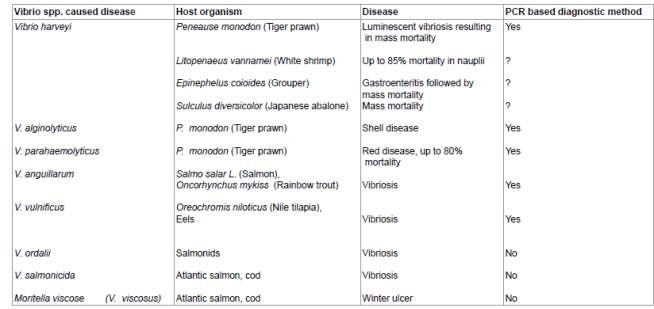 Table 3. Diseases caused by vibrio spp. in aquaculture and availability of PCR based diagnostic methods.
Source: (Shruti 2012)
4.5 Main species in Southeast Asia and Diseases:
Throughout the literature review conducted, it was evident that certain species of aquaculture products were more popular than others (table 3). Two main categories of species studied and looked at in this review were shrimp and fish. Although aquaculture practices in South East Asia is extremely diverse the papers covered in this review focused specifically on two species of shrimp, the nonnative white-legged shrimp and native black tiger shrimp. However there has been a dramatic shift from the dominant species, the black tiger shrimp, to the white legged shrimp (Yano 2014). Consequently these drastic changes affect the occurrence of the bacteria, especially vibrio species as well as their susceptibility to antimicrobials. Red body disease, Aeromonas schubertii is noted to be caused by many pathogens and has caused significant economic loss in shrimp farming in Southeast Asia (Zhang et al., 2011).
Many other bacterial pathogens such as Vibrio parehemoliticus, Vibrio alginoliticus and Proteus penneri have been documented to cause substantial amount of cases of the red body disease of the shrimp (Cao 2014) .More than 600 different animal species (Troell et al., 2014) are produced in aquaculture systems comprising finfish (e.g. catfish, trout, carp, tilapia, salmon), crustaceans (shrimp, prawn, crabs ,freshwater crayfish), and mollusks (e.g. mussels, oysters and clams) (FAO, 2014).For fish farming the popular species noted was tilapia via cage farming (Rico 2014). Other literature illustrated that other popular fish were mainly salmon and catfish.
Table 3. Diseases caused by vibrio spp. in aquaculture and availability of PCR based diagnostic methods.
Source: (Shruti 2012)
4.5 Main species in Southeast Asia and Diseases:
Throughout the literature review conducted, it was evident that certain species of aquaculture products were more popular than others (table 3). Two main categories of species studied and looked at in this review were shrimp and fish. Although aquaculture practices in South East Asia is extremely diverse the papers covered in this review focused specifically on two species of shrimp, the nonnative white-legged shrimp and native black tiger shrimp. However there has been a dramatic shift from the dominant species, the black tiger shrimp, to the white legged shrimp (Yano 2014). Consequently these drastic changes affect the occurrence of the bacteria, especially vibrio species as well as their susceptibility to antimicrobials. Red body disease, Aeromonas schubertii is noted to be caused by many pathogens and has caused significant economic loss in shrimp farming in Southeast Asia (Zhang et al., 2011).
Many other bacterial pathogens such as Vibrio parehemoliticus, Vibrio alginoliticus and Proteus penneri have been documented to cause substantial amount of cases of the red body disease of the shrimp (Cao 2014) .More than 600 different animal species (Troell et al., 2014) are produced in aquaculture systems comprising finfish (e.g. catfish, trout, carp, tilapia, salmon), crustaceans (shrimp, prawn, crabs ,freshwater crayfish), and mollusks (e.g. mussels, oysters and clams) (FAO, 2014).For fish farming the popular species noted was tilapia via cage farming (Rico 2014). Other literature illustrated that other popular fish were mainly salmon and catfish.
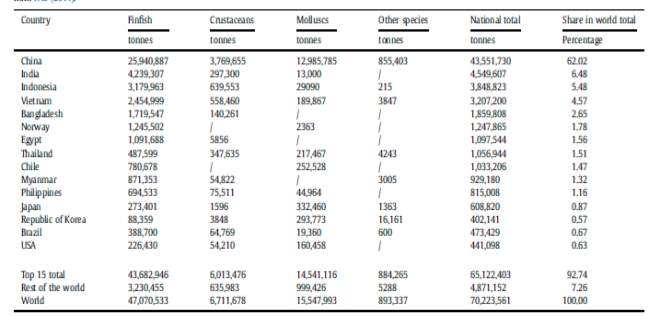 Table 4 Aquaculture production (excluding aquatic photosynthetic organisms) of the top 15 producer countries and shares of the main aquatic groups in 2013 Source of data: (FAO 2014).
4.6 Environmental impacts of pathogens derived from aquaculture and coastal farms:
A number of environmental impacts stem from aquaculture and coastal farms in Southeast Asia. Aquaculture undoubtedly contributes to society, firstly by providing food security and sustainability, socio-economic benefits as well decrease in poverty (Stingers 2016). Nevertheless these positive impacts are countered by other factors such as the drastic global expansion of aquaculture and the pathogens being dispelled into the environment. As a result the rapid growth of this thriving industry has led to a drastic change in large areas of valuable coastal and inland environments. These pathogens from the aquaculture waste pollutes the water and infects organisms and various species of the coastal ecosystems and surrounding environments. From time immemorial aquaculture and pond farming has played an integral role in Southeast Asia, especially China coasts and the major river deltas. These areas are densely populated because of very arable and rich soil and land of these areas along with the diverse marine and freshwater properties (Hellawell 2012).
Pathogens that are transferred to the environment via effluent discharge from these aquaculture and coastal farms leads to ecosystem and food chain pollution. The pathogen rich effluent pollutes the sediment and surrounding areas. This leads to pathogens being spread in the soil and this affects not only the environment and all organisms in the habitat but humans and farmers directly. A main effect mentioned throughout the literature review conducted was habitat modification (figure 8). Farmers use the soil for their respective agricultural practices and these pathogens infect their crops and livestock as well. These pathogens make their way into the rivers, lakes and sea, which consequently affects and infects the natural flora and fauna in their habitats. Fish and other marine organisms become infected with these pathogens and this causes mortality and depletion in species. The water quality is degraded with these pathogens and humans use the water for consumption as well as for recreational purposes and in turn become infected.
Table 4 Aquaculture production (excluding aquatic photosynthetic organisms) of the top 15 producer countries and shares of the main aquatic groups in 2013 Source of data: (FAO 2014).
4.6 Environmental impacts of pathogens derived from aquaculture and coastal farms:
A number of environmental impacts stem from aquaculture and coastal farms in Southeast Asia. Aquaculture undoubtedly contributes to society, firstly by providing food security and sustainability, socio-economic benefits as well decrease in poverty (Stingers 2016). Nevertheless these positive impacts are countered by other factors such as the drastic global expansion of aquaculture and the pathogens being dispelled into the environment. As a result the rapid growth of this thriving industry has led to a drastic change in large areas of valuable coastal and inland environments. These pathogens from the aquaculture waste pollutes the water and infects organisms and various species of the coastal ecosystems and surrounding environments. From time immemorial aquaculture and pond farming has played an integral role in Southeast Asia, especially China coasts and the major river deltas. These areas are densely populated because of very arable and rich soil and land of these areas along with the diverse marine and freshwater properties (Hellawell 2012).
Pathogens that are transferred to the environment via effluent discharge from these aquaculture and coastal farms leads to ecosystem and food chain pollution. The pathogen rich effluent pollutes the sediment and surrounding areas. This leads to pathogens being spread in the soil and this affects not only the environment and all organisms in the habitat but humans and farmers directly. A main effect mentioned throughout the literature review conducted was habitat modification (figure 8). Farmers use the soil for their respective agricultural practices and these pathogens infect their crops and livestock as well. These pathogens make their way into the rivers, lakes and sea, which consequently affects and infects the natural flora and fauna in their habitats. Fish and other marine organisms become infected with these pathogens and this causes mortality and depletion in species. The water quality is degraded with these pathogens and humans use the water for consumption as well as for recreational purposes and in turn become infected.
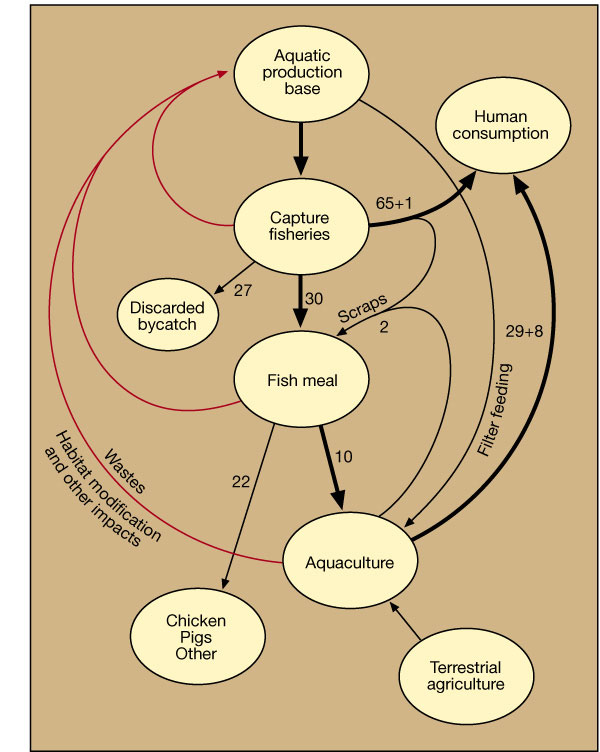 Figure 8. Effects of aquaculture on environment. Numbers refer to 1997 data and are in units of megatons (million metric tons) of fish. Thicker lines refer to direct flows of aquatic primary production through capture fisheries and aquaculture to humans. Thin lines refer to indirect and minor flows. Red lines indicate negative feedbacks on production base.Source: (Naylor 2000)
4.7 Contaminated sediment and spread of diseases:
Within the last two decades with the development of more advanced molecular techniques for testing, this has led to the use of environmental microbes and their genetic material; as indicators of pollution (Sun 2015). Marine sediments contain extremely diverse microbes because of the complex physicochemical gradients therein (Sogin et al.2006). When ponds and aquaculture facilities are drenched the waste soil containing the pathogens are dumped nearby or in nearby coastal environments. The more studied and popular pollutants such as nitrogen, phosphate and trace metals have been a major issue but now antibiotic resistance genes and pathogens harbored by living or dead microorganisms are currently considered as an emerging pollutant (Burgmann 2014).In some cases presented, farmers used the sediment from these ponds after they were drenched as top soil for their crops. These crops therefore are susceptible to any bacteria and pathogens present in the sediment, which in turn affects the chain of demand and flow of energy, as pathogens are being spread at each stage. In a study done in Honk Kong sediment samples were analyzed; two of the top ten families, i.e. Bacillaceae and Peptostreptococcaceae, showed a highly discrepant distribution. Bacillaceae was only enriched in HKSD-104 and HKSD-107 samples, (Guo 2016). The other families revealed a uniform distribution, this illustrates that these sediments have similar bacterial community at least at the taxonomic rank over family level (Figure 9).
Figure 8. Effects of aquaculture on environment. Numbers refer to 1997 data and are in units of megatons (million metric tons) of fish. Thicker lines refer to direct flows of aquatic primary production through capture fisheries and aquaculture to humans. Thin lines refer to indirect and minor flows. Red lines indicate negative feedbacks on production base.Source: (Naylor 2000)
4.7 Contaminated sediment and spread of diseases:
Within the last two decades with the development of more advanced molecular techniques for testing, this has led to the use of environmental microbes and their genetic material; as indicators of pollution (Sun 2015). Marine sediments contain extremely diverse microbes because of the complex physicochemical gradients therein (Sogin et al.2006). When ponds and aquaculture facilities are drenched the waste soil containing the pathogens are dumped nearby or in nearby coastal environments. The more studied and popular pollutants such as nitrogen, phosphate and trace metals have been a major issue but now antibiotic resistance genes and pathogens harbored by living or dead microorganisms are currently considered as an emerging pollutant (Burgmann 2014).In some cases presented, farmers used the sediment from these ponds after they were drenched as top soil for their crops. These crops therefore are susceptible to any bacteria and pathogens present in the sediment, which in turn affects the chain of demand and flow of energy, as pathogens are being spread at each stage. In a study done in Honk Kong sediment samples were analyzed; two of the top ten families, i.e. Bacillaceae and Peptostreptococcaceae, showed a highly discrepant distribution. Bacillaceae was only enriched in HKSD-104 and HKSD-107 samples, (Guo 2016). The other families revealed a uniform distribution, this illustrates that these sediments have similar bacterial community at least at the taxonomic rank over family level (Figure 9).
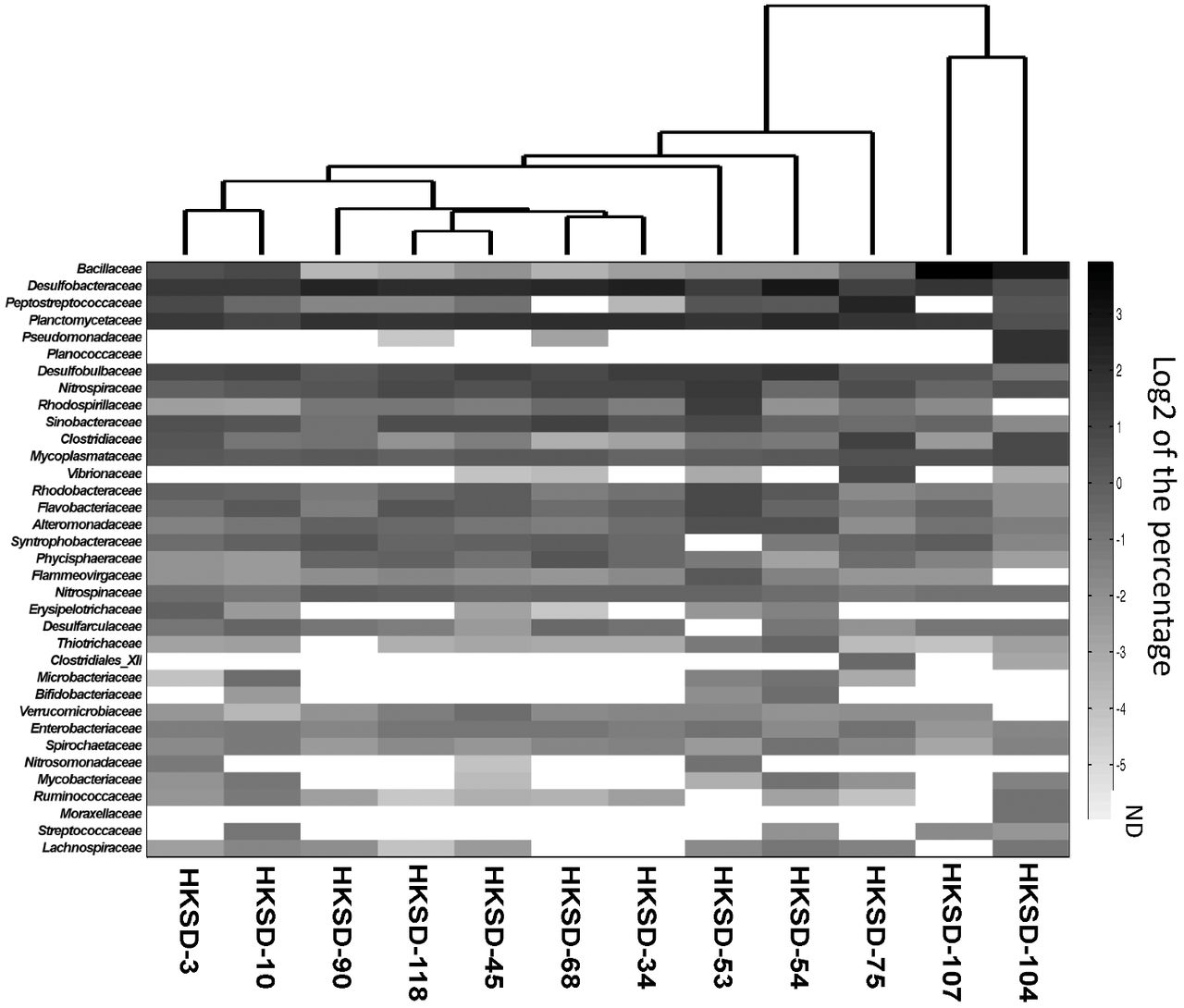 Figure 9: Distribution of the top 35 bacterial families in the 12 sediment samples and the clustering analysis based on the Euclidean distances between samples. The listed families are over 0.5% of relative abundance in at least one sample.
Source: (Guo 2016)
Figure 9: Distribution of the top 35 bacterial families in the 12 sediment samples and the clustering analysis based on the Euclidean distances between samples. The listed families are over 0.5% of relative abundance in at least one sample.
Source: (Guo 2016)
- Antibiotics in aquaculture and coastal farming in South East Asia :
 Figure 8. Researchers’ model of the factors affecting the use of inorganic chemicals in coastal aquaculture in the SCR. Source of data: Bui et al., Cogent Food & Agriculture (2016),
Figure 8. Researchers’ model of the factors affecting the use of inorganic chemicals in coastal aquaculture in the SCR. Source of data: Bui et al., Cogent Food & Agriculture (2016),
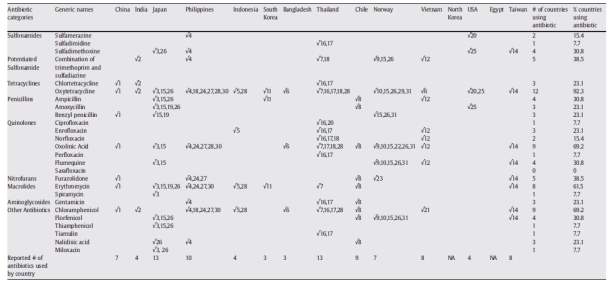 Table 5. Reported antibiotic usage by the top aquaculture producing countries.
Source: (Sapkota 2008)
5.2 Antibiotic regulation in aquaculture
In Southeast Asia; China Vietnam, Thailand, Indonesia, and Myanmar are the main aquaculture producing countries and possess the compulsory and obligatory guidelines, regulations and laws on the proper use of antibiotics (FAO 2016). However the other Southeast Asian countries lack such legislation, agricultural and fisheries extension. An alarming issue is the selection pressure of the use of antimicrobials in aquaculture and coastal farming and this may be attributed to the increase in widespread use of it in aquaculture (Pham 2015.) The main issue that stems from selection pressure is that only a limited amount of approved drugs are readily available to farmers. Misuse and overuse of the antibiotics by farmers is generally due to lack of knowledge and agricultural extensions by the respective agencies.
These farmers are incapable of properly using them and tend to use too much in these parts of Southeast Asia. They tend to use anything that is readily available and economic so salesmen easily convince them, and in some cases it was shown that the farmers tend to use more than one antibiotic [1-3] , (Rico 2014). In these developing countries proper regulation and legislation is not efficiently enforced when it comes to proper antibiotic use in aquaculture. Integrated farming of animal–fish–vegetable, in which antibiotics are used for animal husbandry and animal waste is directly released to aquaculture ponds and applied to rice and vegetable fields, is common in Southeast Asia, this practice causes direct antibiotic contamination and can select for ARBs (Suzuki and Hoa 2012).
5.3 Concerns about antibiotic use:
In bio solids from Southeast Asia, North America, and Europe, 17 antibiotics from five classes were detected at levels of micrograms per kilogram to milligrams per kilogram (dry sludge weight) (Zhang and Li 2011). All literature highlight major concerns with antibiotic use in aquaculture. One main reason being the development of antibiotic resistant genes (ARG’s). The harsh reality is that the prevalence of these unknown ARG and the effects of it has gained significant but necessary attention as antibiotic resistance has resulted in serious threats to human health and all organism health worldwide (Huang 2016). The improper use of it has led to antibiotic resistant genes in the environment. It is noted that these farmers use them irresponsibly as feed additives or medicine for their farming practice but mainly to increase their growth to maximize yield output in aquaculture.
5.4 Outcomes of antibiotic use in aquaculture:
Many of the studies illustrates the adverse effects, fates and ecological risks associated with aquaculture. The fate of the antibiotics and ARG’s are numerous but overall ends up in the environment which in turn affects organisms, humans, animals and plants. Aquaculture production has been recognized as the major ways of these veterinary medications and antibiotics into the environment (Mengaki et al., 2007). Massive quantities of antibiotics utilized in aquaculture and coastal farming has been noted to end up in nearby environments and habitats via sedimentation, leaching or fecal waste runoff into the environment (Rico 2014).According to a report produced by the (WHO), these powerful drugs are now in every corner of the world and pose a significant threat to humans and the environment (Figure 9). The conclusive outcome of antibiotics in aquaculture is that it would enter the environment and affect all living things, where all organisms develop antibiotic resistant genes. In the Asian continent countries such as Vietnam are noted for their vast impact of antibiotic resistant bacteria’s and genes in the environment through environmental contribution of aquaculture and farming practices (figure 9) It causes food chain pollution by causing toxicity and irreversible damage to farmed species and human health via consumption and diseases just to name a few.
Table 5. Reported antibiotic usage by the top aquaculture producing countries.
Source: (Sapkota 2008)
5.2 Antibiotic regulation in aquaculture
In Southeast Asia; China Vietnam, Thailand, Indonesia, and Myanmar are the main aquaculture producing countries and possess the compulsory and obligatory guidelines, regulations and laws on the proper use of antibiotics (FAO 2016). However the other Southeast Asian countries lack such legislation, agricultural and fisheries extension. An alarming issue is the selection pressure of the use of antimicrobials in aquaculture and coastal farming and this may be attributed to the increase in widespread use of it in aquaculture (Pham 2015.) The main issue that stems from selection pressure is that only a limited amount of approved drugs are readily available to farmers. Misuse and overuse of the antibiotics by farmers is generally due to lack of knowledge and agricultural extensions by the respective agencies.
These farmers are incapable of properly using them and tend to use too much in these parts of Southeast Asia. They tend to use anything that is readily available and economic so salesmen easily convince them, and in some cases it was shown that the farmers tend to use more than one antibiotic [1-3] , (Rico 2014). In these developing countries proper regulation and legislation is not efficiently enforced when it comes to proper antibiotic use in aquaculture. Integrated farming of animal–fish–vegetable, in which antibiotics are used for animal husbandry and animal waste is directly released to aquaculture ponds and applied to rice and vegetable fields, is common in Southeast Asia, this practice causes direct antibiotic contamination and can select for ARBs (Suzuki and Hoa 2012).
5.3 Concerns about antibiotic use:
In bio solids from Southeast Asia, North America, and Europe, 17 antibiotics from five classes were detected at levels of micrograms per kilogram to milligrams per kilogram (dry sludge weight) (Zhang and Li 2011). All literature highlight major concerns with antibiotic use in aquaculture. One main reason being the development of antibiotic resistant genes (ARG’s). The harsh reality is that the prevalence of these unknown ARG and the effects of it has gained significant but necessary attention as antibiotic resistance has resulted in serious threats to human health and all organism health worldwide (Huang 2016). The improper use of it has led to antibiotic resistant genes in the environment. It is noted that these farmers use them irresponsibly as feed additives or medicine for their farming practice but mainly to increase their growth to maximize yield output in aquaculture.
5.4 Outcomes of antibiotic use in aquaculture:
Many of the studies illustrates the adverse effects, fates and ecological risks associated with aquaculture. The fate of the antibiotics and ARG’s are numerous but overall ends up in the environment which in turn affects organisms, humans, animals and plants. Aquaculture production has been recognized as the major ways of these veterinary medications and antibiotics into the environment (Mengaki et al., 2007). Massive quantities of antibiotics utilized in aquaculture and coastal farming has been noted to end up in nearby environments and habitats via sedimentation, leaching or fecal waste runoff into the environment (Rico 2014).According to a report produced by the (WHO), these powerful drugs are now in every corner of the world and pose a significant threat to humans and the environment (Figure 9). The conclusive outcome of antibiotics in aquaculture is that it would enter the environment and affect all living things, where all organisms develop antibiotic resistant genes. In the Asian continent countries such as Vietnam are noted for their vast impact of antibiotic resistant bacteria’s and genes in the environment through environmental contribution of aquaculture and farming practices (figure 9) It causes food chain pollution by causing toxicity and irreversible damage to farmed species and human health via consumption and diseases just to name a few.
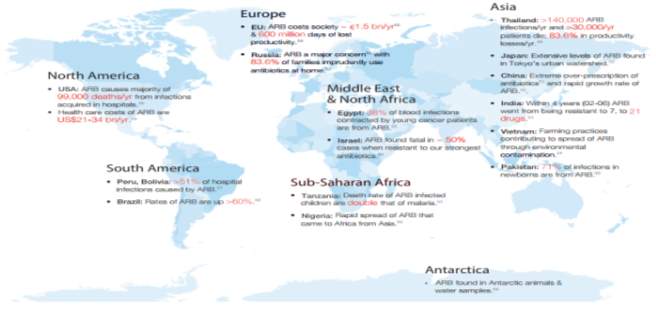 Figure 9. Landmark global report on antibiotic resistance. Source: (WHO 2014)
5.5 Mitigating development of antibiotics resistant organisms:
Development of strategies for mitigating the severity of antibiotic resistant organisms is now a top priority for global public and environmental health (Spellberg 2008). Healthcare officials and veterinarians should refrain from prescribing and dispensing antibiotics unless they are necessary and all other measures have been explored and what specific antibiotic if needed should be prescribed. Ensure that respective antibiotics to be used are solely done for the purpose of treating infectious diseases and should be properly monitored by veterinarians. Misuse and overuse in agriculture and aquaculture are the main reasons that lead to antibiotic resistance and its subsequent spread into the food chain via the environment and to humans (Marshall 2011). Proper cleanliness and uncrowded conditions along with vaccination of species could reduce the need for these antibiotics.
In order for an aquaculture site to be considered properly functioning and environmentally safe, they should only be permitted to continue their practice only if their operation shows that it is capable and will maintain a healthy environment for wild animals, the environment and the natural habitats nearby (Mara 1989). Various environmental factors are assessed prior to an aquaculture and coastal farm being allowed to operate. Some of these factors include nutrient discharge, protection against escapes of farmed animals, protocols for maintaining fish health, potential impacts to the benthic environment, and many others (FAO 2014).
The government and respective organizations need to take immediate action places to tackle this issue head front. By regulating, monitoring and passing legislation to properly control use of antibiotics. They most importantly need to implement measures to monitor its use, regulating the appropriate use of quality medication and education and agricultural extensions of the effects of misuse and overuse. Industries needs to move faster and more aggressively to research and develop new antibiotics, but we also have to implement new ways of stimulating research and development. Overall it is evident that a more holistic global approach is needed.
5.6 Alternatives to antibiotic use:
There is urgent need for research to be done and develop alternative medication and therapies for bacterial pathogens aquaculture and coastal farming (Verschuere 2000). Appropriate antibiotic prescribing should be done in severe cases. However due to the dire circumstances that arise form antibiotic resistance alternatives should be a main option. One idyllic method would be vaccination as this prevents the diseases from infecting the organisms (Romero 2012). There are many management alternatives across agriculture, wastewater treatment, aquaculture, and pharmaceutical manufacturing that could assist in eliminating risks of antimicrobial resistance in the environment (Pruden 2013).
Many substitutions have been effectively used so far such as using innocuous microorganism to fight infection by the bacteria. Another useful alternative is probiotics. Majority of the literature concerning the use of probiotics are studies on application of a single bacterial strain. Nevertheless, the environments that the aquatic organisms are reared are changed on an often basis and have significant effects on the health of the hosts. It is has been suggested that a probiotics which contains several bacteria’s could be more efficient at controlling bacterial pathogens
Essential oils which are volatile liquids are another alternative that have been used. This approach has been only recently tested and the use of it in aquaculture seems very promising (Courchesne et al. Wang 2009) .It has been suggested that they can disrupt the permeability of the bacterial cell membrane. There is limited research available regarding the in vivo antibacterial effects of essential oils in aquaculture and coastal farming, but great interest is rising in the use of these natural compounds as an alternative to antibiotic use.
Phage therapy is listed as a potential therapy for aquaculture. This technique was first used in aquaculture with the work of (Nakai et., al 1999) but with time has been reviewed and improved (Almedia et al. 2009) the phages enter the body of the organism and can be detected in the kidney of fish.
Conclusion:
The global increase in demand for aquaculture and intensive aquaculture practices has resulted in many bacterial diseases being spread and disseminated into the environment. This then has led to the consequent increase in use, overuse and abuse of antimicrobials and chemicals. As a result significant growth in concern about the impacts of antibiotics on the environment and the health of all living organisms has led to more legislation and regulations being applied to the control of antibiotic use. The large quantity of antibiotic resistant bacteria and genes that persist in waste from aquaculture, sediments and farm environments is a direct threat to the ecosystem.
Since antibiotic resistant bacteria is transferable in humans and animals and hence capable of transferring their resistance to human pathogens, the implementation of efficient strategies to control and manage properly the prevalence is this resistant gene and its spread is very life-threatening. In addition to the effects on human, animal, plant and ecosystem health, the improper and ineffective treatment using antibiotics of diseases and illness in aquaculture lead to major economic loss. Two approaches that have been thought to be efficient, is the reduction of antibiotic use in aquaculture and to apply rearing practices and techniques that would minimize stress on the species being cultivated. This in turn would reduce the probability of infections that would require antibiotic treatment.
Southeast Asia being the largest producer and exporter of aquaculture products needs to take immediate corrective measurements to alleviate this problem and stop further environmental damage and harm to humans and animals. The pathogens and ARG’S in these areas are not only transferred to their surrounding but also globally. Therefore all governmental agencies and organizations need to deal with this issue and minimize its effect immediately. More educational campaigns and extension programs especially in aquaculture production needs to be disseminated and made available to these farmers. They should be properly trained and educated so that the practice proper aquaculture farming techniques and minimize use of antibiotics. Most importantly to deal with this strict regulation, penalties need to be enforced and testing done regularly to monitor this global crisis. Numerous alternatives to antibiotics have been developed such as phage therapy, probiotics use, essential oils and some cases have illustrated where they have been successful in controlling bacterial infections in aquaculture facilities. Although these alternatives to aquaculture are very promising more research has to be done in order to gain more insight about it in order to improve and also evaluate their effects on the environment and the host micro biota. Antibiotic resistance and pathogens derived from aquaculture is a serious threat to the world and it is imperative that more research, regulation and control be done to mitigate further detrimental incidences.
REFERENCES:
Figure 9. Landmark global report on antibiotic resistance. Source: (WHO 2014)
5.5 Mitigating development of antibiotics resistant organisms:
Development of strategies for mitigating the severity of antibiotic resistant organisms is now a top priority for global public and environmental health (Spellberg 2008). Healthcare officials and veterinarians should refrain from prescribing and dispensing antibiotics unless they are necessary and all other measures have been explored and what specific antibiotic if needed should be prescribed. Ensure that respective antibiotics to be used are solely done for the purpose of treating infectious diseases and should be properly monitored by veterinarians. Misuse and overuse in agriculture and aquaculture are the main reasons that lead to antibiotic resistance and its subsequent spread into the food chain via the environment and to humans (Marshall 2011). Proper cleanliness and uncrowded conditions along with vaccination of species could reduce the need for these antibiotics.
In order for an aquaculture site to be considered properly functioning and environmentally safe, they should only be permitted to continue their practice only if their operation shows that it is capable and will maintain a healthy environment for wild animals, the environment and the natural habitats nearby (Mara 1989). Various environmental factors are assessed prior to an aquaculture and coastal farm being allowed to operate. Some of these factors include nutrient discharge, protection against escapes of farmed animals, protocols for maintaining fish health, potential impacts to the benthic environment, and many others (FAO 2014).
The government and respective organizations need to take immediate action places to tackle this issue head front. By regulating, monitoring and passing legislation to properly control use of antibiotics. They most importantly need to implement measures to monitor its use, regulating the appropriate use of quality medication and education and agricultural extensions of the effects of misuse and overuse. Industries needs to move faster and more aggressively to research and develop new antibiotics, but we also have to implement new ways of stimulating research and development. Overall it is evident that a more holistic global approach is needed.
5.6 Alternatives to antibiotic use:
There is urgent need for research to be done and develop alternative medication and therapies for bacterial pathogens aquaculture and coastal farming (Verschuere 2000). Appropriate antibiotic prescribing should be done in severe cases. However due to the dire circumstances that arise form antibiotic resistance alternatives should be a main option. One idyllic method would be vaccination as this prevents the diseases from infecting the organisms (Romero 2012). There are many management alternatives across agriculture, wastewater treatment, aquaculture, and pharmaceutical manufacturing that could assist in eliminating risks of antimicrobial resistance in the environment (Pruden 2013).
Many substitutions have been effectively used so far such as using innocuous microorganism to fight infection by the bacteria. Another useful alternative is probiotics. Majority of the literature concerning the use of probiotics are studies on application of a single bacterial strain. Nevertheless, the environments that the aquatic organisms are reared are changed on an often basis and have significant effects on the health of the hosts. It is has been suggested that a probiotics which contains several bacteria’s could be more efficient at controlling bacterial pathogens
Essential oils which are volatile liquids are another alternative that have been used. This approach has been only recently tested and the use of it in aquaculture seems very promising (Courchesne et al. Wang 2009) .It has been suggested that they can disrupt the permeability of the bacterial cell membrane. There is limited research available regarding the in vivo antibacterial effects of essential oils in aquaculture and coastal farming, but great interest is rising in the use of these natural compounds as an alternative to antibiotic use.
Phage therapy is listed as a potential therapy for aquaculture. This technique was first used in aquaculture with the work of (Nakai et., al 1999) but with time has been reviewed and improved (Almedia et al. 2009) the phages enter the body of the organism and can be detected in the kidney of fish.
Conclusion:
The global increase in demand for aquaculture and intensive aquaculture practices has resulted in many bacterial diseases being spread and disseminated into the environment. This then has led to the consequent increase in use, overuse and abuse of antimicrobials and chemicals. As a result significant growth in concern about the impacts of antibiotics on the environment and the health of all living organisms has led to more legislation and regulations being applied to the control of antibiotic use. The large quantity of antibiotic resistant bacteria and genes that persist in waste from aquaculture, sediments and farm environments is a direct threat to the ecosystem.
Since antibiotic resistant bacteria is transferable in humans and animals and hence capable of transferring their resistance to human pathogens, the implementation of efficient strategies to control and manage properly the prevalence is this resistant gene and its spread is very life-threatening. In addition to the effects on human, animal, plant and ecosystem health, the improper and ineffective treatment using antibiotics of diseases and illness in aquaculture lead to major economic loss. Two approaches that have been thought to be efficient, is the reduction of antibiotic use in aquaculture and to apply rearing practices and techniques that would minimize stress on the species being cultivated. This in turn would reduce the probability of infections that would require antibiotic treatment.
Southeast Asia being the largest producer and exporter of aquaculture products needs to take immediate corrective measurements to alleviate this problem and stop further environmental damage and harm to humans and animals. The pathogens and ARG’S in these areas are not only transferred to their surrounding but also globally. Therefore all governmental agencies and organizations need to deal with this issue and minimize its effect immediately. More educational campaigns and extension programs especially in aquaculture production needs to be disseminated and made available to these farmers. They should be properly trained and educated so that the practice proper aquaculture farming techniques and minimize use of antibiotics. Most importantly to deal with this strict regulation, penalties need to be enforced and testing done regularly to monitor this global crisis. Numerous alternatives to antibiotics have been developed such as phage therapy, probiotics use, essential oils and some cases have illustrated where they have been successful in controlling bacterial infections in aquaculture facilities. Although these alternatives to aquaculture are very promising more research has to be done in order to gain more insight about it in order to improve and also evaluate their effects on the environment and the host micro biota. Antibiotic resistance and pathogens derived from aquaculture is a serious threat to the world and it is imperative that more research, regulation and control be done to mitigate further detrimental incidences.
REFERENCES:
- Ahmed, M., & Lorica, M. H. (2002). Improving developing country food security through aquaculture development—lessons from Asia. Food Policy, 27(2), 125-141.
- Ahmed, M., & Lorica, M. H. (2002). Improving developing country food security through aquaculture development—lessons from Asia. Food Policy, 27(2), 125-141.
- Alexandratos, N., & Bruinsma, J. (2012). World agriculture towards 2030/2050: the 2012 revision (No. 12-03, p. 4). Rome, FAO: ESA Working paper.
- Allan, J. D., & Flecker, A. S. (1993). Biodiversity conservation in running waters. BioScience, 43(1), 32-43.
- Andrieu, M., Rico, A., Phu, T. M., Phuong, N. T., & Van den Brink, P. J. (2015). Ecological risk assessment of the antibiotic enrofloxacin applied to Pangasius catfish farms in the Mekong Delta, Vietnam. Chemosphere, 119, 407-414.
- Archer, D. L., & Young, F. E. (1988). Contemporary issues: diseases with a food vector. Clinical microbiology reviews, 1(4), 377-398.
- Blaber, S. J. (2008). Tropical estuarine fishes: ecology, exploration and conservation. John Wiley & Sons.
- Bostock, J., McAndrew, B., Richards, R., Jauncey, K., Telfer, T., Lorenzen, K., ... & Corner, R. (2010). Aquaculture: global status and trends. Philosophical Transactions of the Royal Society of London B: Biological Sciences, 365(1554), 2897-2912.
- Cao, H., He, S., Lu, L., Yang, X., & Chen, B. (2014). Identification of a Proteus penneri isolate as the causal agent of red body disease of the cultured white shrimp Penaeus vannamei and its control with Bdellovibrio bacteriovorus. Antonie van Leeuwenhoek, 105(2), 423-430.
- Chatterjee, S., & Haldar, S. (2012). Vibrio related diseases in aquaculture and development of rapid and accurate identification methods. Journal of Marine Science Research and Development S, 1.
- Choi, H. Y., Thatikonda, S., Zhu, Y. G., & Carriquiriborde, P. (2014). Potential ecological footprints of active pharmaceutical.
- Courchesne, N. M. D., Parisien, A., Wang, B., & Lan, C. Q. (2009). Enhancement of lipid production using biochemical, genetic and transcription factor engineering approaches. Journal of biotechnology, 141(1), 31-41.
- Cowx, I. G., O'Grady, K. T., Welcomme, R. L., & Bartley, D. M. (1998). Current approaches to the enhancement of fisheries. Fisheries Management and Ecology, 5(5), 351-382.
- De Silva, S. S., & Soto, D. (2009). Climate change and aquaculture: potential impacts, adaptation and mitigation. Climate change implications for fisheries and aquaculture: overview of current scientific knowledge. FAO Fisheries and Aquaculture Technical Paper, (530), 151-212.
- Drake, S. L., DePaola, A., & Jaykus, L. A. (2007). An overview of Vibrio vulnificus and Vibrio parahaemolyticus. Comprehensive Reviews in Food Science and Food Safety, 6(4), 120-144.
- Feldhusen, F. (2000). The role of seafood in bacterialfoodborne diseases. Microbes and Infection, 2(13), 1651-1660.
- Feng Guo, Bing Li, Ying Yang, Yu Deng, Jian-Wen Qiu, Xiangdong Li, Kenneth MY Leung, Tong Zhang; Impacts of human activities on distribution of sulfate-reducing prokaryotes and antibiotic resistance genes in marine coastal sediments of Hong Kong. FEMS Microbiol Ecol 2016; 92 (9): fiw128. doi: 10.1093/femsec/fiw128.
- Folke, C., & Kautsky, N. (1992). Aquaculture with its environment: prospects for sustainability. Ocean & coastal management, 17(1), 5-24.
- Founou, L. L., Founou, R. C., & Essack, S. Y. (2016). Antibiotic resistance in the food chain: A developing country-perspective. Frontiers in Microbiology, 7.
- Garcia, S. M., & Rosenberg, A. A. (2010). Food security and marine capture fisheries: characteristics, trends, drivers and future perspectives. Philosophical Transactions of the Royal Society B: Biological Sciences, 365(1554), 2869-2880.
- Gürtler, V., Harford, C., Bywater, J., & Mayall, B. C. (2006). Direct identification of slowly growing Mycobacterium species by analysis of the intergenic 16S-23S rDNA spacer region (ISR) using a GelCompar II database containing sequence based optimization for restriction fragment site polymorphisms (RFLPs) for 12 enzymes. Journal of microbiological methods, 64(2), 185-199.
- Guy, J. A., McIlgorm, A., & Waterman, P. (2014). Aquaculture in Regional Australia: Responding to trade externalities. A Northern NSW case study. Journal of Economic & Social Policy, 16(1), 115.
- Haendiges, J. (2014). Pandemic Vibrio parahaemolyticus, Maryland, USA, 2012-Volume 20, Number 4—April 2014-Emerging Infectious Disease journal-CDC.
- He, X., Deng, M., Wang, Q., Yang, Y., Yang, Y., & Nie, X. (2016). Residues and health risk assessment of quinolones and sulfonamides in cultured fish from Pearl River Delta, China. Aquaculture, 458, 38-46.
- Hellawell, J. M. (Ed.). (2012). Biological indicators of freshwater pollution and environmental management. Springer Science & Business Media.
- Huang, Y. (2013). Vibrant risks: scientific aquaculture and political ecologies in China (Doctoral dissertation).
- Igbinosa, E. O., & Okoh, A. I. (2008). Emerging Vibrio species: an unending threat to public health in developing countries. Research in microbiology, 159(7), 495-506.
- Islam, M. S., & Tanaka, M. (2004). Impacts of pollution on coastal and marine ecosystems including coastal and marine fisheries and approach for management: a review and synthesis. Marine pollution bulletin, 48(7), 624-649.
- Joshi, P. K., Gulati, A., Birthal, P. S., & Tewari, L. (2004). Agriculture diversification in South Asia: patterns, determinants and policy implications. Economic and Political Weekly, 2457-2467.
- Justé, A., Thomma, B. P. H. J., & Lievens, B. (2008). Recent advances in molecular techniques to study microbial communities in food-associated matrices and processes. Food Microbiology, 25(6), 745-761.
- Kautsky, N., Rönnbäck, P., Tedengren, M., & Troell, M. (2000). Ecosystem perspectives on management of disease in shrimp pond farming. Aquaculture, 191(1), 145-161.
- King, V. T., & Wilder, W. D. (2003). The modern anthropology of South-East Asia: an introduction (Vol. 1). Psychology Press.
- Kobayashi, M., Msangi, S., Batka, M., Vannuccini, S., Dey, M. M., & Anderson, J. L. (2015). Fish to 2030: the role and opportunity for aquaculture. Aquaculture Economics & Management, 19(3), 282-300.
- Kümmerer, K. (Ed.). (2008). Pharmaceuticals in the environment: sources, fate, effects and risks. Springer Science & Business Media.
- Laxminarayan, R., Duse, A., Wattal, C., Zaidi, A. K., Wertheim, H. F., Sumpradit, N., ... & Greko, C. (2013). Antibiotic resistance—the need for global solutions. The Lancet infectious diseases, 13(12), 1057-1098.
- Lopes, R. J., Almeida, J., Dias, P. J., Pinho, P., & Maciel, M. J. (2009). Infectious thoracic aortitis: a literature review. Clinical cardiology, 32(9), 488-490.
- Manjusha, S., & Sarita, B. G. (2006). Studies on isolation and molecular characterization of plasmids from Vibrios (Doctoral dissertation, Cochin University of Science and Technology).
- Mara, D. D., & Cairncross, S. (1989). Guidelines for the safe use of wastewater and excreta in agriculture and aquaculture (p. 187). Geneva: World Health Organization.
- Marshall, B. M., & Levy, S. B. (2011). Food animals and antimicrobials: impacts on human health. Clinical microbiology reviews, 24(4), 718-733.
- Natale, F., Hofherr, J., Fiore, G., & Virtanen, J. (2013). Interactions between aquaculture and fisheries. Marine Policy, 38, 205-213.
- Naylor, R. L., Goldburg, R. J., Primavera, J. H., Kautsky, N., Beveridge, M. C., Clay, J., ... & Troell, M. (2000). Effect of aquaculture on world fish supplies. Nature, 405(6790), 1017-1024.
- Oetama, V. S., Hennersdorf, P., Abdul-Aziz, M. A., Mrotzek, G., Haryanti, H., & Saluz, H. P. (2016). Microbiome analysis and detection of pathogenic bacteria of Penaeus monodon from Jakarta Bay and Bali. Marine pollution bulletin, 110(2), 718-725.
- Ottinger, M., Clauss, K., & Kuenzer, C. (2016). Aquaculture: Relevance, distribution, impacts and spatial assessments–A review. Ocean & Coastal Management, 119, 244-266.
- Pillay, T. V. R. (2008). Aquaculture and the Environment. John Wiley & Sons.
- Pimentel, D., Lach, L., Zuniga, R., & Morrison, D. (2000). Environmental and economic costs of nonindigenous species in the United States. BioScience, 50(1), 53-65.
- Primavera, J. (2006). Overcoming the impacts of aquaculture on the coastal zone. Ocean & Coastal Management, 49(9), 531-545.
- Pruden, A. (2013). Balancing water sustainability and public health goals in the face of growing concerns about antibiotic resistance.
- Qi, W. (2002). Social and economic impacts of aquatic animal health problems in aquaculture in China. population, 250(500), 750.
- Reilly, A., & Käferstein, F. (1997). Food safety hazards and the application of the principles of the hazard analysis and critical control point (HACCP) system for their control in aquaculture production. Aquaculture research, 28(10), 735-752.
- Rico A, Van den Brink PJ. Probabilistic risk assessment of veterinary medicines applied to four major aquaculture species produced in Asia. Sci Total Environ. 2014;468:630–41
- Rico, A., Oliveira, R., McDonough, S., Matser, A., Khatikarn, J., Satapornvanit, K., ... & Van den Brink, P. J. (2014). Use, fate and ecological risks of antibiotics applied in tilapia cage farming in Thailand. Environmental Pollution, 191, 8-16.
- Romero, J., Feijoó, C. G., & Navarrete, P. (2012). Antibiotics in aquaculture-use, abuse and alternatives. INTECH Open Access Publisher.
- Rose, J. B., Epstein, P. R., Lipp, E. K., Sherman, B. H., Bernard, S. M., & Patz, J. A. (2001). Climate variability and change in the United States: potential impacts on water-and foodborne diseases caused by microbiologic agents. Environmental health perspectives, 109(Suppl 2), 211.
- Sapkota, A., Sapkota, A. R., Kucharski, M., Burke, J., McKenzie, S., Walker, P., & Lawrence, R. (2008). Aquaculture practices and potential human health risks: current knowledge and future priorities. Environment international, 34(8), 1215-1226.
- Simberloff, D., Parker, I. M., & Windle, P. N. (2005). Introduced species policy, management, and future research needs. Frontiers in Ecology and the Environment, 3(1), 12-20.
- Singh, R. B. (2014). Towards a food secure India and South Asia: making hunger history. Asia-Pacific Association of Agricultural Research Institutions,(APAARI), Available online at http://www. apaari. org/wp-content/uploads/2009/08/towards-a-food-secure-india-making-hunger-history. pdf. DoA, 26.
- Sogin, M. L., Morrison, H. G., Huber, J. A., Welch, D. M., Huse, S. M., Neal, P. R., ... & Herndl, G. J. (2006). Microbial diversity in the deep sea and the underexplored “rare biosphere”. Proceedings of the National Academy of Sciences, 103(32), 12115-12120.
- Spellberg, B., Guidos, R., Gilbert, D., Bradley, J., Boucher, H. W., Scheld, W. M., ... & Infectious Diseases Society of America. (2008). The epidemic of antibiotic-resistant infections: a call to action for the medical community from the Infectious Diseases Society of America. Clinical Infectious Diseases, 46(2), 155-164.
- Sun, M., Ye, M., Wu, J., Feng, Y., Wan, J., Tian, D., ... & Jiang, X. (2015). Positive relationship detected between soil bioaccessible organic pollutants and antibiotic resistance genes at dairy farms in Nanjing, Eastern China. Environmental Pollution, 206, 421-428.
- Taylor, M. D., Chick, R. C., Lorenzen, K., Agnalt, A. L., Leber, K. M., Blankenship, H. L., ... & Loneragan, N. R. (2017). Fisheries enhancement and restoration in a changing world.
- The State of World Fisheries and Aquaculture Opportunities and challenges FOOD AND AGRICULTURE ORGANIZATION OF THE UNITED NATIONS Rome, 2014
- Troell, M., Naylor, R. L., Metian, M., Beveridge, M., Tyedmers, P. H., Folke, C., ... & Gren, Å. (2014). Does aquaculture add resilience to the global food system?. Proceedings of the National Academy of Sciences, 111(37), 13257-13263.
- Urbanik, J., & Johnston, C. (Eds.). (2017). Humans and Animals: A Geography of Coexistence. ABC-CLIO.
- Verschuere, L., Rombaut, G., Sorgeloos, P., & Verstraete, W. (2000). Probiotic bacteria as biological control agents in aquaculture. Microbiology and molecular biology reviews, 64(4), 655-671.
- Wilcove, D. S., Rothstein, D., Dubow, J., Phillips, A., & Losos, E. (1998). Quantifying Threats to Imperiled Species in the United States Assessing the relative importance of habitat destruction, alien species, pollution, overexploitation, and disease. BioScience, 48(8), 607-615.
- Wittenberg, R., & Cock, M. J. (Eds.). (2001). Invasive alien species: a toolkit of best prevention and management practices. CABI.
- Wong, M. H. (2017). Chemical pollution and seafood safety, with a focus on mercury: The case of Pearl River Delta, South China. Environmental Technology & Innovation, 7, 63-76.
- Yano, Y., Hamano, K., Satomi, M., Tsutsui, I., Ban, M., & Aue-Umneoy, D. (2014). Prevalence and antimicrobial susceptibility of Vibrio species related to food safety isolated from shrimp cultured at inland ponds in Thailand. Food control, 38, 30-36.
- Yano, Y., Hamano, K., Satomi, M., Tsutsui, I., Ban, M., & Aue-Umneoy, D. (2014). Prevalence and antimicrobial susceptibility of Vibrio species related to food safety isolated from shrimp cultured at inland ponds in Thailand. Food control, 38, 30-36.
- Yeung, P. M., & Boor, K. J. (2004). Epidemiology, pathogenesis, and prevention of foodborne Vibrio parahaemolyticus infections. Foodborne Pathogens & Disease, 1(2), 74-88.
- Zhang, T., & Li, B. (2011). Occurrence, transformation, and fate of antibiotics in municipal wastewater treatment plants. Critical reviews in environmental science and technology, 41(11), 951-998.
Cite This Work
To export a reference to this article please select a referencing stye below:
Related Services
View allRelated Content
All TagsContent relating to: "Marine Studies"
Marine studies look at the oceans and seas from the resources they provide, the diverse organisms and life that live in them to the threats and effects of climate change on marine habitats.
Related Articles
DMCA / Removal Request
If you are the original writer of this dissertation and no longer wish to have your work published on the UKDiss.com website then please:




